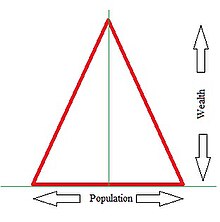
Back قاعدة الهرم Arabic Base of the Pyramid German Βάση της πυραμίδας Greek Base de la pirámide Spanish ベイス・オブ・ザ・ピラミッド Japanese Основание пирамиды Russian

The bottom of the pyramid, bottom of the wealth pyramid, bottom of the income pyramid or the base of the pyramid is the largest, but poorest socio-economic group. In global terms, this is the 2.7 billion people who live on less than $2.50 a day.[1][2]
Management scholar CK Prahalad popularised the idea of this demographic as a profitable consumer base in his 2004 book The Fortune at the Bottom of the Pyramid, written alongside Stuart Hart.[3]
- ^ "Definition of bottom of the pyramid (BOP)". ft.com/lexicon. Nikkei. Archived from the original on May 5, 2017. Retrieved May 3, 2017.
Technically, a member of the BOP is part of the largest but poorest groups of the world's population, who live with less than $2.50 a day and are excluded from the modernity of our globalised civilised societies, including consumption and choice as well as access to organised financial services.
- ^ Malik, Khalid (2014), "Chapter 1: Vulnerability and human development" (PDF), Human Development Report: Sustaining Human Progress, New York: United Nations Development Programme, p. 19, ISBN 978-92-1-126368-8, retrieved May 3, 2017,
Globally, 1.2 billion people (22 percent) live on less than $1.25 a day. Increasing the income poverty line to $2.50 a day raises the global income poverty rate to about 50 percent, or 2.7 billion people.
- ^ Bajaj, Vikas (April 21, 2010). "C. K. Prahalad, Proponent of Poor as Consumers, Dies at 68". New York Times. Retrieved May 3, 2017.
C. K. Prahalad, a management professor and author who popularized the idea that companies could make money while helping to alleviate poverty, died Friday in the La Jolla neighborhood of San Diego.
© MMXXIII Rich X Search. We shall prevail. All rights reserved. Rich X Search